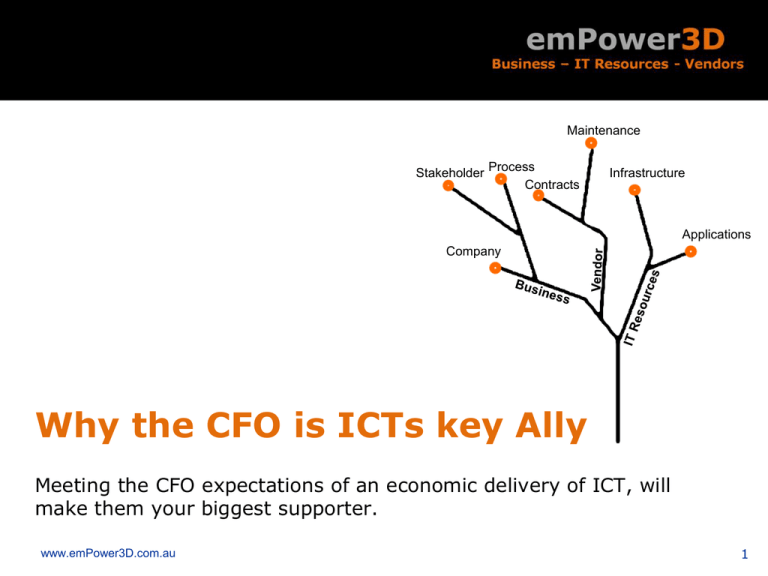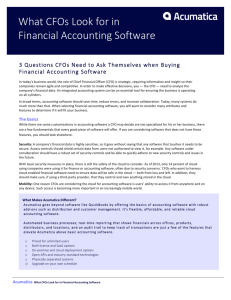Why the CFO is ICTs key Ally
advertisement

Maintenance Stakeholder Process Contracts Infrastructure Applications Company Why the CFO is ICTs key Ally Meeting the CFO expectations of an economic delivery of ICT, will make them your biggest supporter. www.emPower3D.com.au 1 The CFO – CIO Relationship • CIOs are one of the largest spenders of capital in many organisations. • CFOs are responsible to shareholders to make sure capital is spent wisely and with a clear return on investment focus. • CFOs look towards the CIO and expect to see a well formed business case with a rock solid ROI for each of the ICT investments. • CIOs struggle to find solid ROI in many of their ICT initiatives • CIOs are on an abstract search for the best technology • CFOs are on the search of the best return on capital CFOs and CIOs need to work together build business focused, ROI driven business cases for ICT initiatives. www.emPower3D.com.au 2 Research shows that CFO believe in ICT • In the Deloitte’s 2013 CFO Signals survey, most CFOs in the US view the transformational impact of technology as far-reaching. • When asked about their priorities for capability improvement, CFOs listed IT/information management second after strategic planning, • The CFO, and other members of the c-suite need to work with the CIO to create an understanding that ICT expenditure must yield an ROI return to gain the Boards and Shareholder support. • It is extremely important for both CIOs and CFOs to act as true business partners and keep an open dialogue to ensure that these new investments are keeping pace with the rapid change in the business. www.emPower3D.com.au 3 Align IT investment with business strategy • CIOs have the opportunity to turn ICT into a strategic partner of the business by ensuring there is a clear line of sight from the technology investments to positive business outcomes. • “CIOs have a real opportunity to have a seat at the table and to get involved in not only developing strategy but really helping to execute strategy,” says Michael Bradburn, CFO at Brisbane Airport Corporation. • When a CIO is invited to the Business Strategy meeting they are not technologists; they are a business person solving business problems with their special technology expertise. • A CIO must be a language translator and convert abstract technology statements into clear business statements. www.emPower3D.com.au 4 Be proactive about forming business partnerships • While a good CIO will engage with overall business strategy, they must also develop and encourage their ICT team to build professional business partnerships. • “Be proactive,” says Tim Riitters, CFO for PureStorage. “Even if a CIO doesn’t sit at the CEO level staff they still should spend time with leaders across the organisation to understand the company's strategic imperatives, in order to know how to leverage technology to support these strategies.” • “It is a key piece of information that will ensure technology is being used optimally,” says Riitters. “It is an ongoing partnership where two heads are really better than one.” These interactions can also ensure that the c-suites will gain a deeper understanding of what the CIOs role entails, which aids them in developing realistic expectations. www.emPower3D.com.au 5 Guide the CFO on the benefits of ICT • Being an IT leader means guiding CFOs through priority issues to illustrate how technology can be leveraged to achieve real results, such as enabling strategy, increasing competitiveness, or improving operational effectiveness. • Communicating these benefits, however, means recognising that not everyone is adept at speaking the technical language of IT. • CIOs need to spend more time tailoring the benefits of the IT function to each of the different business divisions, because each of those leaders will have different needs. • What frustrates CFOs the most are surprise and unplanned capital expenditure. • All ICT capital expenditure can and should be well planned. www.emPower3D.com.au 6 The language of the CIO • An IT leader that talks only about what their function does isn’t going to connect with the Business; they need to sell the benefits that are specific to each of the different divisions. • This means listening to what those needs are and packaging an a solution that is focused on the benefit, and not the function, of IT. • Adopting a shared language is also beneficially from a cultural point of view. Without it, working relationships for both internal • The language of finance is a far better tool to describe ICT investments than the language of technlogy. www.emPower3D.com.au 7 Be transparent about pricing • CFOs may lament working with a CIO that does not exercising transparency and strategic decision-making when it comes to the costs associated with IT projects. • “ICT will always cost more if the business doesn’t have transparency on pricing,” says Bradburn. • If ICT has transparency, the business will always make a better decision. If a business requests a new program or system, if they don’t have transparency as to what those costs are (which is generally the case) they’ll always ask for more than they need.” www.emPower3D.com.au 8 CIO and the search for the best technology • The server that’s available 24/7 with no down time seems most appealing, but if the CIO presents a transparent pricing guide that shows an alternative with an hour of downtime a day for a million dollars less, this will lead to better business decision. • Quite often the business will say they don’t want to pay that much of a premium for 24/7, they can actually deal with it being down for an hour, particularly if it saves them a million dollars. www.emPower3D.com.au 9 The final words CIO who strategically rejects ICT investment proposals that don’t make enough business sense, while ensuring that they don’t disrupt the business, will always be a good partner to the CFO www.emPower3D.com.au 10











